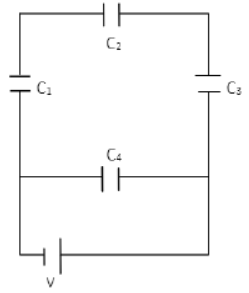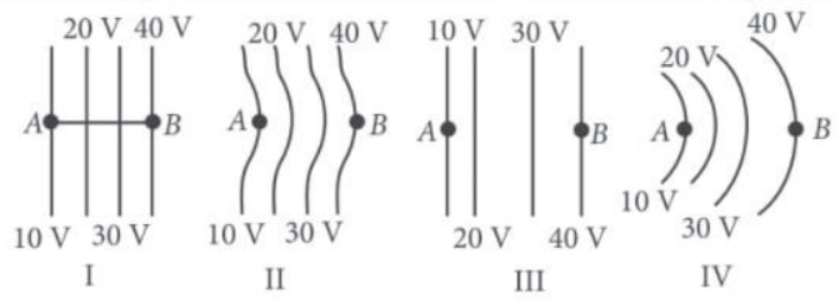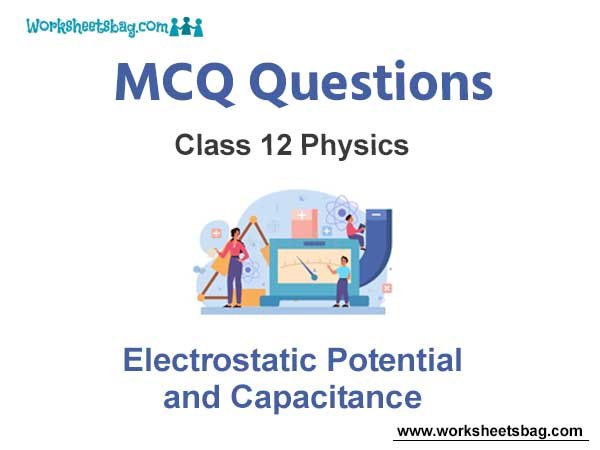Please refer to Electrostatic Potential and Capacitance MCQ Questions Class 12 Physics below. These MCQ questions for Class 12 Physics with answers have been designed as per the latest NCERT, CBSE books, and syllabus issued for the current academic year. These objective questions for Electrostatic Potential and Capacitance will help you to prepare for the exams and get more marks.
Electrostatic Potential and Capacitance MCQ Questions Class 12 Physics
Please see solved MCQ Questions for Electrostatic Potential and Capacitance in Class 12 Physics. All questions and answers have been prepared by expert faculty of standard 12 based on the latest examination guidelines.
MCQ Questions Class 12 Physics Electrostatic Potential and Capacitance
Question. Which of the following statement is true?
(a) Electrostatic force is a conservative force.
(b) Potential at a point is the work done per unit charge in bringing a charge from any point to infinity.
(c) Electrostatic force is non-conservative.
(d) Potential is the product of charge and work.
Answer
A
Question. 1 volt is equivalent to
(a) newton/second
(b) newton/coulomb
(c) joule/coulomb
(d) joule/second
Answer
C
Question. The work done in bringing a unit positive charge from infinite distance to a point at distance x from a positive charge Q is W. Then the potential f at that point is
(a) WQ/x
(b) W
(c) W/x
(d) WQ
Answer
B
Question. Consider a uniform electric field in the z-direction. The potential is a constant
(a) for any x for a given z
(b) for any y for a given z
(c) on the x – y plane for a given z
(d) all of these
Answer
D
Question. Equipotential surfaces
(a) are closer in regions of large electric fields compared to regions of lower electric fields.
(b) will be more crowded near sharp edges of a conductor.
(c) will always be equally spaced.
(d) both (a) and (b) are correct
Answer
D
Question. In a region of constant potential
(a) the electric field is uniform.
(b) the electric field is zero.
(c) there can be no charge inside the region.
(d) both (b) and (c) are correct.
Answer
D
Question. A test charge is moved from lower potential point to a higher potential point. The potential energy of test charge will
(a) remain the same
(b) increase
(c) decrease
(d) become zero
Answer
C
Question. An electric dipole of moment p→ is placed in a uniform electric field E→ . Then
(i) the torque on the dipole is p→ X E→
(ii) the potential energy of the system is p→ X E→
(iii) the resultant force on the dipole is zero.
Choose the correct option.
(a) (i), (ii) and (iii) are correct
(b) (i) and (iii) are correct and (ii) is wrong
(c) only (i) is correct
(d) (i) & (ii) are correct & (iii) is wrong
Answer
B
Question. If a conductor has a potential V ≠ 0 and there are no charges anywhere else outside, then
(a) there must be charges on the surface or inside itself.
(b) there cannot be any charge in the body of the conductor.
(c) there must be charges only on the surface.
(d) both (a) and (b) are correct.
Answer
C
Question. Which of the following statements is false for a perfect conductor?
(a) The surface of the conductor is an equipotential surface.
(b) The electric field just outside the surface of a conductor is perpendicular to the surface.
(c) The charge carried by a conductor is always uniformly distributed over the surface of the conductor.
(d) None of these.
Answer
D
Question. Dielectric constant for a metal is
(a) zero
(b) infinite
(c) 1
(d) 10
Answer
B
Question. When air is replaced by a dielectric medium of constant K, the maximum force of attraction between two charges separated by a distance
(a) increases K times
(b) remains unchanged
(c) decreases K times
(d) increases K–1 times
Answer
C
Question. In a parallel plate capacitor, the capacity increases if
(a) area of the plate is decreased.
(b) distance between the plates increases.
(c) area of the plate is increased.
(d) dielectric constantly decreases.
Answer
C
Question. A parallel plate air capacitor is charged to a potential difference of V volts. After disconnecting the charging battery the distance between the plates of the capacitor is increased using an insulating handle. As a result the potential difference between the plates
(a) increases
(b) decreases
(c) does not change
(d) becomes zero
Answer
A
Question. Two identical capacitors are joined in parallel, charged to a potential V, separated and then connected in series, the positive plate of one is connected to the negative of the other. Which of the following is true?
(a) The charges on the free plated connected together are destroyed.
(b) The energy stored in this system increases.
(c) The potential difference between the free plates is 2V.
(d) The potential difference remains constant.
Answer
C
Question. A capacitor has some dielectric between its plates, and the capacitor is connected to a dc source. The battery is now disconnected and then the dielectric is removed, then
(a) capacitance will increase.
(b) energy stored will decrease.
(c) electric field will increase.
(d) voltage will decrease.
Answer
C
Question. A parallel plate capacitor has capacitance 18μF. The distance between its plates is doubled and a dielectric medium of constant K is completely filled between its plates. Its capacitance now becomes 72μF. The value of K is
(a) 6
(b) 4
(c) 8
(d) 2
Answer
C
Question. A parallel plate capacitor has uniform electric field E between its plates. If the distance between the plates is d and area of each plate of capacitor is A then energy stored by the capacitor is
(a) εo E2 /2
(b) εo E2 /2dA
(c) εo E Ad/2
(d) εo E2 Ad /2
Answer
D
Question. An electric dipole of diploe moment p is placed in an external electric field, E = 104 N/C such that the dipole moment makes 30o angle with the direction of electric field. Torque experienced by the dipole is 10√3 Nm.
The magnitude of electrostatic PE of the dipole is
(a) 30 x 104 J
(b) 3J
(c) 0.3J
(d) 30J
Answer
D
Question. Four capacitors each of capacitance C are connected as shown.

The ratio of charge stored by C2 and C4 is
(a) 1 : 1
(b) 1 : 2
(c) 1 : 3
(d) 3 : 1
Answer
C
Question. A point charge +Q is fixed at the origin. Work done by the external force in moving a charge +Q from infinity to a fixed point distant r from the origin is
(a) kQ/r
(b) – kQ/r
(c) kQ2 /r
(d) – kQ2 /r
Answer
C
Question. The diagram below shows regions of equipotentials. A positive point charge is moved from A to B. Identify the correct statement:

(a) Work done in moving the point charge is same in all the four cases.
(b) Minimum work is required to move the point charge in figure I
(c) Maximum work is required to move the point charge in figure III
(d) No work is required to move the point charge in figure IV.
Answer
A
Question. A hollow metal sphere of radius 10cm is charged such that the potential at its surface becomes 80V. The potential at the centre of the sphere is
(a) 8V
(b) 80 V
(c) 0.8 V
(d) Zero
Answer
B
Question. Potential in a region of space is expressed as V(x,y,z) = 6xy – y + 2yz The component of electric field along Y axis at (1, 1, 0) is
(a) 1unit
(b) 6 units
(c) 5 units
(d) 4 units
Answer
C
Question. A parallel plate capacitor of capacitance C is connected to a cell of emf V. It is then disconnected from the cell and an uncharged capacitor of capacitance 2C is now connected in parallel with it. Identify the correct statement.
(a) The two capacitors finally have equal charge.
(b) The energy stored by the combination of capacitors is lesser than the energy stored by the first capacitor.
(c) ) The energy stored by the combination of capacitors is equal to the energy stored by the first capacitor.
(d) The capacitance of the combination is lesser than the capacitance of the first capacitor.
Answer
B
Question. Three point charges Q, -Q and -2Q are placed at the vertices of an equilateral triangle of side a. The separation between the charges is increased to 2a by applying an external force. The change in electrostatic potential energy of the system is
(a) 2kQ2 /a
(b) kQ2 /a
(c) kQ2 /2a
(d) 3kQ2 /2a
Answer
C
Question. Two spherical conductors each of capacity C are charged to potential V and –V. These are then connected by means of a fine wire. The loss of energy is
(a) zero
(b) (1/ 2)CV2
(c) CV2
(d) 2 CV2
Answer
C
Read the two statements Assertion (A) and Reason (R) carefully to mark the correct option out of the options given below:
(a) Assertion (A) and Reason (R) both are correct statements and Reason is correct explanation for Assertion.
(b) Assertion (A) and Reason (R) both are correct statements but Reason is not correct explanation for Assertion.
(c) Assertion (A) is correct statement but Reason (R) is wrong statement.
(d) Assertion (A) is wrong statement but Reason (R) is correct statement.
Question. Assertion: Positive charge always moves from a higher potential point to a lower potential point.
Reason: Electric potential is a vector quantity.
Answer
C
Question. Assertion: Electric potential of the earth is zero.
Reason: The electric field due to the earth is zero.
Answer
C
Question. Assertion: When air between the plates of a parallel plate condenser is replaced by an insulating medium of dielectric constant its capacity increases.
Reason: Electric field intensity between the plates with dielectric in between it is reduced.
Answer
A
Question. Assertion: Two adjacent conductors, carrying the same positive charge have no potential difference between them.
Reason: The potential of a conductor does not depend upon the charge given to it.
Answer
D
Question. Assertion: A capacitor is connected to a battery. If we move its plate further apart, work will be done against the electrostatic attraction between the plates and the energy of the capacitor gets decreased.
Reason: The energy stored in capacitor is dissipated in the form of heat energy.
Answer
B
Question. Assertion: A capacitor can be broken by placing large amount of charge on it.
Reason: After breakage potential, capacitor is destroyed.
Answer
B
Question. Assertion: Charge on all the condensers connected in series is the same.
Reason: Capacitance of capacitor is directly proportional to charge on it.
Answer
C
Question. Assertion: The surface of a conductor is anequipotential surface.
Reason: Conductor allows the flow of charge.
Answer
A
Question. Assertion: No work is done in taking a positive charge from one point to other inside a positive charged metallic sphere while outside the sphere work is done in taking the charge toward the sphere.
Reason: Inside the sphere electric potential is same at each potential, but outside it is different for different points.
Answer
A
Question. Assertion: An electric field is preferred in comparison to magnetic field for detecting the electron beam in a television picture tune.
Reason: Electric field requires low voltage.
Answer
D


